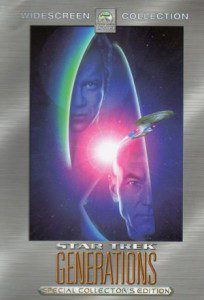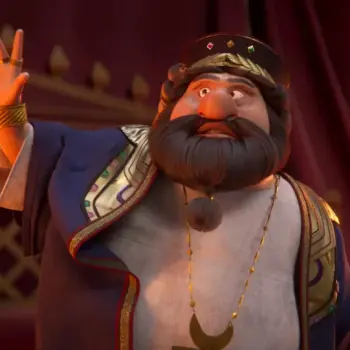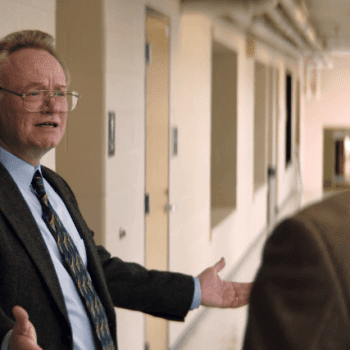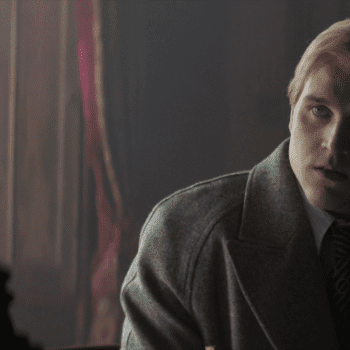 I said something earlier about ST5:TFF being a wasted opportunity. Star Trek: Generations (hereafter known as ST:G) was an even bigger opportunity, and thus, as it turned out, may have been an even bigger waste. It has been ten years — an entire decade — since Captain James T. Kirk bit the dust, and until I watched the “collector’s edition” DVD today, I don’t believe I had seen the film at all since the three times I caught it in the theatre back then; indeed, you could say I still haven’t seen it again, since I watched it with both the audio and text commentaries turned on, and thus wasn’t really paying attention to the dialogue, etc. But even with those bonus-feature distractions — and indeed, partly because of them, since the voices on the commentary express many gripes with the finished product! — it is still evident to me that ST:G was a clumsily made film, and a rather pathetic note on which to really, really, really end the original series.
I said something earlier about ST5:TFF being a wasted opportunity. Star Trek: Generations (hereafter known as ST:G) was an even bigger opportunity, and thus, as it turned out, may have been an even bigger waste. It has been ten years — an entire decade — since Captain James T. Kirk bit the dust, and until I watched the “collector’s edition” DVD today, I don’t believe I had seen the film at all since the three times I caught it in the theatre back then; indeed, you could say I still haven’t seen it again, since I watched it with both the audio and text commentaries turned on, and thus wasn’t really paying attention to the dialogue, etc. But even with those bonus-feature distractions — and indeed, partly because of them, since the voices on the commentary express many gripes with the finished product! — it is still evident to me that ST:G was a clumsily made film, and a rather pathetic note on which to really, really, really end the original series.
ST6:TUC may have marked the last appearance of the full original-series cast, but ST:G is the film in which Kirk becomes the first member of the original Enterprise crew who dies and stays dead (unless you consider William Shatner’s Star Trek novels canonical!); it is also the last of the films to take place, even partially, in the 23rd century, and it brings back Scotty and Chekov, as well as introducing us to Sulu’s daughter. And as a fan of the original series, I have always rather liked the prologue, in which Kirk sits on a ship’s bridge for the last time in his life — but on the sidelines, not in the captain’s chair; indeed, the second or third time I saw this film, I was rather moved by Kirk’s refusal to sit in the Enterprise-B’s captain’s chair, knowing that his commitment to principle over personal satisfaction would soon spell his end. Moments like those ring very true to the character, and I’m grateful that the film gave us those last glimpses of Kirk in action.
But after that scene — oy vey! How lame that Kirk should “die” by being sucked into space during some random lame-o impromptu rescue mission gone wrong. Can it really be that that is how Kirk’s end was recorded in the history books, and that all those characters in the 24th century — including the much, much older McCoy and Sarek — have always believed Kirk had met his end this way? And how lame that Kirk should die a second time, and this time for real, by running around like some ill-fated red-shirt on an Enterprise-D mission. I know, I know, it would have been impossible to bring back the entire original-series cast and have a true meeting of the two shows … but still! Kirk was never all that interesting when he ran around punching people; his defining moments were always moments of decision and leadership, and that is sorely lacking in this film’s final act. This DVD also includes the original ending to the film, in which Soran (the Malcolm McDowell character) shoots Kirk in the back, and then Picard gets his revenge by shooting Soran more or less in cold blood (though I guess we could call it excessive force in the service of self-defense) — how could so many people have thought that an ending like that would have worked? Lame. Pathetic. And certainly neither of these endings gives Kirk a death anywhere near as meaningful as Spock’s in ST2:TWOK.
(Speaking of deleted scenes, the DVD includes another one that was going to start the film, in which Scotty and Chekov stand on the ground waiting for Kirk to finish a bout of orbital skydiving; it has that Starfleet-crew-on-vacation vibe that the opening scenes in ST5:TFF had, but if it was implausible then that, e.g., Sulu and Chekov should go on leave together, and not with their families, then it is even more implausible that Kirk should be hanging out with Scotty and Chekov, and not with, say, Spock and McCoy. Of course, the original script did call for Spock and McCoy to come back, but neither Leonard Nimoy nor DeForest Kelley was interested in reviving their roles, having said good-bye to them in the previous film. One thing that makes this deleted scene extra-strange is that it appears they were planning on intercutting between the Kirk-Scotty-Chekov scene and that special-effect sequence in which the champagne bottle is sent hurtling towards the Enterprise-B — I would have found the opening credits utterly incomprehensible if they had gone that route. Fortunately, they got the beginning of the film just about right, in the end, I think.)
Curiously, this is the only DVD so far in the Trek movie series in which none of the audio commentary is provided by the director; instead, it is provided by the two screenwriters. To judge from his IMDB page, director David Carson appears to be alive, still, so I can only speculate as to why he did not participate in this project; however, I note also that Carson has only directed one other feature film in his life — some obscure Wesley Snipes action movie — and that all of his other credits, which go back a few decades, are in TV. Unfortunately, ST:G does feel like a TV episode made by people who had a lot of money on their hands, rather than like a feature film (a fact exemplified, perhaps, by Dennis McCarthy’s score, which is easily one of the worst soundtracks in the Star Trek catalogue).
The film also feels terribly disjointed, partly because — as the writers themselves admit — they were trying to juggle too many formula elements and to please too many people at once. First you’ve got a sequence on the Enterprise-B. Then you’ve got an incredibly ginormous holodeck sequence. Then you’ve got a shoot-out on a space lab. Then you’ve got a rather convoluted hostage exchange (“If you give us back our crewmate, we’ll let you beam our captain down to the planet to talk to that other guy”). Then you’ve got a fantastic, extended Enterprise-D crash sequence. Then you’ve got this Victorian Christmas sequence in the Nexus. Then you’ve got Kirk scrambling eggs and riding horses. Then you’ve got a big mano a mano fight sequence on a rocky hill. Then, the end. It’s all rather disjointed; in fact, the awkward structure of it all kind of reminds me of The Last Temptation of Christ, which packs the life of Christ (a subject that ordinarily takes up an entire movie on its own) into its first two acts (if we can even think of Last Temptation in conventional three-act terms) and then spins off into some sort of alternate reality, before coming back in time and putting history back the way it was meant to be. (The parallels are actually rather eerie, the more I think about them — I’m surprised this had never occurred to me before.)
The writers are remarkably candid about how many things in the movie just don’t work the way they’d wanted them to: the sight of Picard wiggling through a hole in the rocks, the scene where Kirk and Picard scramble some eggs together (it was intended to be “charming and offbeat”, but now they find it “just painful” to watch), the “treacly” nature of the scene where Picard’s “children” thank him for their Christmas presents, the fact that Kirk’s line about “making a difference” doesn’t really “stick” with the other themes in the film (facing mortality, the effect that time has on us), etc. They also express qualms with aspects of the film that might not have been due to their script, e.g., they cannot recall whether it was in the script that Picard cries when he hears about his relatives’ deaths, or whether it was something Patrick Stewart decided to do; but either way, they don’t like the fact that Picard is seen crying in his first big movie. (Personally, I don’t mind the scene at all; I like the fact that Picard is human enough to show his vulnerability like that.) And they make some other interesting observations as well, e.g., they figure nothing will date ST:TNG more than the fact that a “therapist” like Counselor Troi was put not just on the ship, but on the bridge of the ship; they say it feels “very ’80s”. They also express some ambivalence about the fact that there were children on the Enterprise-D — a few good story ideas did come out of that situation, they admit, but, well, given how often the Enterprise-D was destroyed in parallel timelines (before finally being blown up in this film), it does seem odd.
The writers remark that this film, of all the ST:TNG films, is the most “true” to the show, and I think that’s true, but I think that may also have been one of the things that hindered it; certainly, the fact that ST5:TFF felt more like a regular episode of the original series than any of the other early films did not help that film in any way. It is also interesting to consider that this was the first of the films that depicted events which coincided with events on the other TV shows; ST:DS9 was just starting its third season when this film came out, and of course the future films will all have to find tricky ways to bring Worf back on the Enterprise despite the fact that he has been re-assigned to Deep Space 9. And yet the prologue, on the Enterprise-B, feels like it could have flowed naturally straight out of the previous six films. I get weird thoughts whenever I think of that prologue, actually, because it really does exist in some middle space between “an extension and continuation of the previous films, which all take place in the 23rd century” and “a trivial historical footnote, from the point of view of the 24th century”.
As you can see, I have difficulty leaving the original series behind. But hey, what can I say, it’s hard to forget the earlier films when ST:G recycles footage from the older movies. Now, there is a fair bit of recycling in the earlier films, too — the shots of the Enterprise leaving spacedock in ST:TMP were re-used in ST2:TWOK, and the ‘Genesis Planet’ footage in that film was re-used in ST3:TSFS and ST4:TVH, but I don’t object to this because none of these recycled shots was really “the point” of the story; those shots were all essentially in the background somewhere. But in ST:G, when the Enterprise-D blows up the Klingon sisters’ Bird of Prey, the film uses the exact same shot of General Chang’s Bird of Prey exploding from ST6:TUC — and I’m sorry, but you just can’t use one film’s climactic moment to depict another film’s climactic moment.
Let’s see, what else. Oh, yeah, when the scene of Data saying “Oh, shit” comes up, one of the writers remarks that this is the “first profanity” ever spoken on Star Trek — but that is not true. In ST4:TVH, Kirk had to assure Gillian, the whale expert, that there was “no dipshit” in what he was trying to tell her; one might also want to argue that expressions like “double dumb-ass on you” fall into the realm of profanity, depending on what kind of “ass” is under discussion there. What I would like to know is whether these expressions, which had apparently fallen out of fashion by the 23rd century, were somehow revived in the 24th — or is Data’s use of such an outdated expression an indication that he still hasn’t figured out how to use his emotion chip properly?
Speaking of Data, I did get a kick out of the writers’ claim that Brent Spiner hates cats, and thus hated having to do all those scenes with Spot — and they claim you can actually see just how much the cat can sense that Spiner hates it. And I also got a kick out of the fact that, not only did William Shatner know that the writers had thrown horses into the film in order to persuade him to appear in it, but Shatner also rented his horses to the production company, to make just a little more money!
Thankfully, the Star Trek franchise did have at least one more good movie left in it — but that was it. And while I’ve never been a big ST:TNG fan, I do think it’s kind of sad that only one of the four films produced by that generation turned out okay. Ah well.
— A version of this post was first posted to the OnFilm discussion group.












